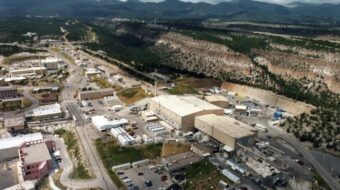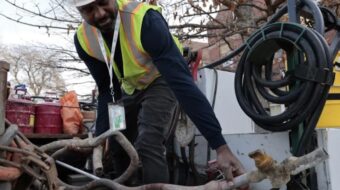
Workers struggling to stem the oil flow on the Gulf Coast are falling ill as concern grows about the short- and long-term effects of exposure to crude oil and the chemicals being used to clean it up. Some who have gotten sick are filing class actions suits against BP while others are demanding temporary restraining orders against the giant oil company.
Workers have been hospitalized with rashes, nausea, chest pains, headaches and shortness of breath. The company has blocked workers involved in the cleanup from talking to the press. And BP has forbidden cleanup crews to wear breathing masks and other protective equipment.
BP CEO Tony Haywood claimed the sickness was due to food poisoning. “You know, there’s a … food poisoning is a really big issue when you’ve got a concentration of this many people in ten pre-cabs, ten pre-accommodations. It’s something we have to be very, very mindful of” he said.
Anne Womack-Kolton, Dick Cheney’s former press secretary, has been hired by BP to handle publicity during the crisis. She also formerly worked for the Department of Energy under the Bush administration.
A chemical called Corexit 9500 is being used to break up the oil spill. The Environmental Protection Agency has asked BP to use another less toxic substance. So far a mutually agreed-to dispersant has not been found.
Last week the Obama administration voiced its concerns about the environmental and health impacts of the spill. “We’re very concerned about the impact of disaster on the public health of people in the Gulf region,” said Health and Human Services Secretary Kathleen Sebelius.
As the crisis intensifies, toxic substances are not only poisoning the water but also the air. Propublica.org notes that “dispersants’ toxins may be making its way into the air that workers are breathing. Air sampling data gathered to ensure the safety of cleanup workers has identified a chemical compound in the air that is also in the dispersants BP is applying to the Gulf.”
The article continues, “Little-noticed data posted on BP’s website and the Deepwater Horizon site show that 32 air samples taken near workers have indicated the presence of butoxyethanol, a component listed as present in an oil spill dispersant used by BP, known as Corexit. The Environmental Protection Agency considers it toxic.”
Propublica.org cautions about attributing a causal relationship between dispersant use and illness in workers, but notes workers are becoming sick.
The Louisiana Shrimpers Association charges that workers have been threatened by BP. CNN reports that “BP told workers they were not allowed to wear masks.” Clint Guidry, the president of the shrimpers association, told CNN, “Some of our men asked, and they were told they’d be fired if they wore masks.” BP has denied making threats.
Meanwhile the Center for Biological Diversity is suing the EPA for not stopping the use of untested chemicals that may prove a dire threat to the ecosystem on the Gulf Coast. “The Gulf of Mexico has become Frankenstein’s laboratory for BP’s enormous, uncontrolled experiment in flooding the ocean with toxic chemicals,” said Andrea Treece, an attorney with the center.
In both the Exxon Valdez oil spill and the 9/11 terrorist attack, workers experienced long-term health problems despite government assurances of safe working conditions.
Photo: Cleanup workers on the Gulf. http://creativecommons.org/licenses/by-sa/2.0/deed.en












Comments